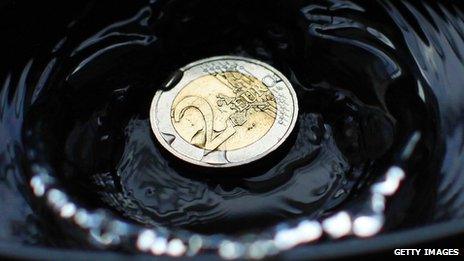Is this really 'banking union'?
- Published
- comments

It was a banking crisis, in late 2011, that almost destroyed the eurozone - and would have done, if the European Central Bank hadn't weighed in with unprecedentedly cheap loans to struggling banks and a pledge to do "whatever it takes" to keep the monetary-union show on the road.
But the ECB's succour represented short-term emergency treatment, not the kind of long-term reforms that would succeed in breaking the vicious connection between bloated weak banks and individual sovereign states lacking the resources to bail out those weak banks.
Which is why the stakes were so high for the so-called "banking union" being created to accompany "monetary union" and - in particular - the creation of what is known as a "Single Resolution Mechanism", intended to minimise the collateral damage from bank failures.
A successful resolution system has to achieve two things when a bank gets into difficulties, if the damage to all our wealth is to be minimised - there needs to be speedy action to maintain the really essential functions of the bank, and the financial costs of propping up the good bits of the bank and quarantining the bad need to fall as little as possible on taxpayers.
So after all the fraught negotiation to create the Single Resolution Mechanism, will it meet those two criteria - or is it a traditional eurozone plate of fudge and mudge, a breakfast concoction fit primarily for canine consumption.
I will leave you to be the judge of that.
But it is striking that finance ministers have not wholly delegated the decision-making on whether to close or take over an ailing bank to a new resolution board they are creating. They have reserved powers to determine the fate of struggling banks for themselves - which does not augur well for the most speedy action in a crisis.
Equally, for at least 10 years - and possibly forever - it is individual member states that will remain the ultimate underwriters of the costs when one of their banks fail, rather than eurozone members collectively.
So very little has been achieved to reassure the creditors of Spain and Italy, for example, that the resources have been created to rehabilitate their over-stretched banking systems without putting an excessive burden on their respective public finances.
That said, steps have been taken to reduce the burden on the taxpayers of member states - by forcing losses, via a new Bank Resolution and Recovery Directive, on banks' most well-heeled creditors (holders of bank bonds and those with deposits that exceed 100,000 euros).
And there will be a new pan-eurozone resolution fund, created by a levy on individual eurozone banks.
But here is what made me chuckle. After 10 years, by 2026, that fund will contain in its coffers 55bn euros.
Does that sound like a lot of money to you? Well it's a pimple in the context of the monumentally huge balance sheets of eurozone banks.
Here is one way of seeing how little it is.
It is considerably less than the British government spent on propping up one bank, Royal Bank of Scotland.
And it is exactly the same, $75bn, as the US Federal Reserve is still spending every single month on bond purchases, even after last night's historic announcement of tapering, the decision by the Fed to reduce the scale of those bond purchases by $10bn per month.
Or to put it another way, Germany's insistence that nothing should be agreed that could prevent any future German government insulating German taxpayers from the costs of rescuing feckless banks in other parts of the eurozone have resulted in a resolution system whose credibility is - well - questionable.